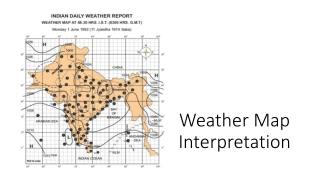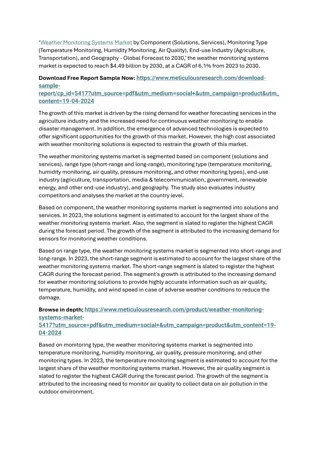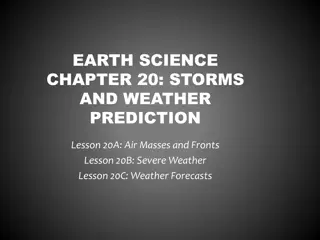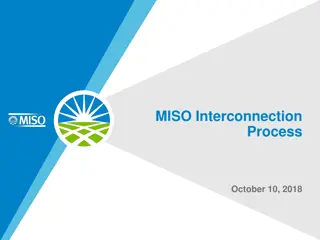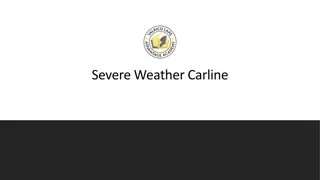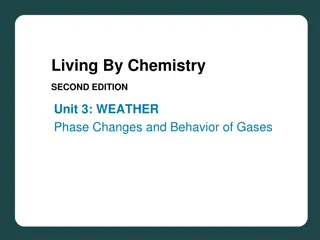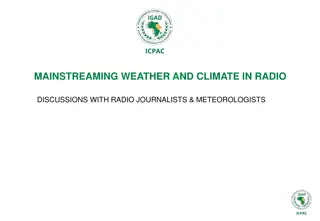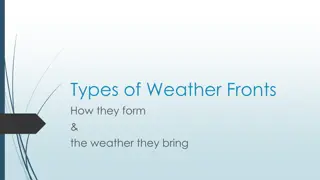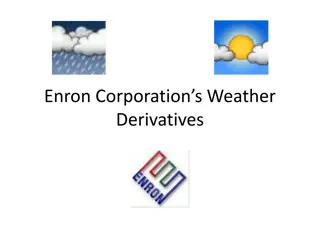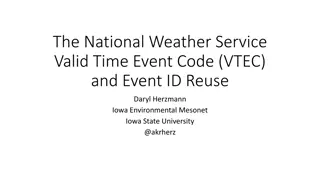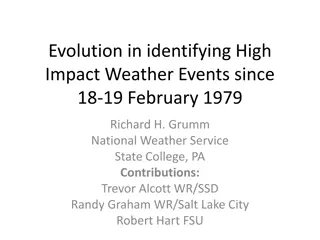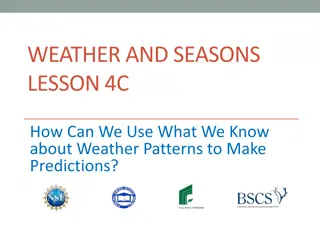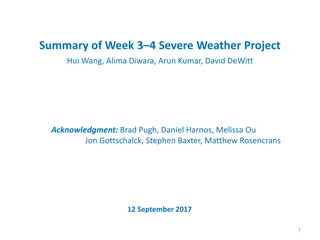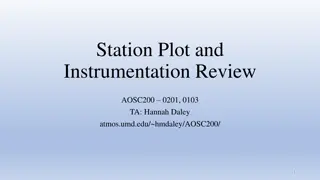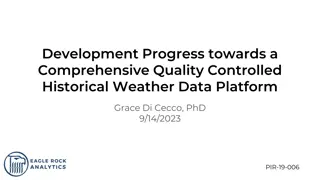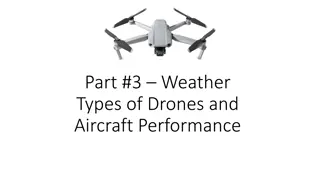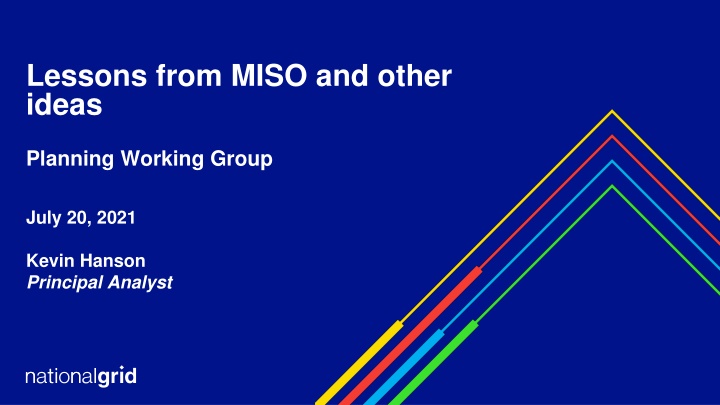
Lessons from MISO: Weather Challenges and Planning Strategies
Weather volatility in ERCOT, including significant storms like Harvey and Uri, highlights the importance of proactive planning. Explore initiatives by MISO and Midwest ISO to enhance the planning process and address gas-electric risks.
Uploaded on | 2 Views
Download Presentation

Please find below an Image/Link to download the presentation.
The content on the website is provided AS IS for your information and personal use only. It may not be sold, licensed, or shared on other websites without obtaining consent from the author. If you encounter any issues during the download, it is possible that the publisher has removed the file from their server.
You are allowed to download the files provided on this website for personal or commercial use, subject to the condition that they are used lawfully. All files are the property of their respective owners.
The content on the website is provided AS IS for your information and personal use only. It may not be sold, licensed, or shared on other websites without obtaining consent from the author.
E N D
Presentation Transcript
Lessons from MISO and other ideas Planning Working Group July 20, 2021 Kevin Hanson Principal Analyst
Why do we need to do something? Weather is getting more volatile. In ERCOT, we have had: 1) 2011 (summer was 1 in 100 event), 2) Three separate 500 year storms in the past 5 years (e.g. Harvey), 3) Uri which is somewhere between a 30 year (1989 to 2021) or a 100 year storm | PLWG July 20, 2021 2 National Grid
Examples for MISO | US Offshore Wind - 24 June 2019
Projects Midwest ISO has done to improve the planning process Gas Studies 1) 2) Added gas models into their planning process (Plexos and GPCM gas models) | PLWG July 20, 2021 4 National Grid
Projects Midwest ISO has done to improve the planning process Investigating pipeline contingency events 1) 2) Support ongoing work at other agencies looking at Gas-Electric Risks | PLWG July 20, 2021 5 National Grid
Projects MISO has done to improve the non-planning process MISO has improved communication & situational awareness around pipeline activities and impacts to generators 1) 2) MISO s Gas Pipeline Notifications Website provides regional insight into pipeline operating conditions 3) Fuel Impact Report: At Risk Units 4) Control Room Electric/Gas Pipeline Real Time Display 5) Gas Usage Profiles Project 6) MISO Winter Generator Survey 7) Generator-Pipeline Database Upgrade a) MISO now has complete database of pipeline connections and dual fuel capability for all gas generators | PLWG July 20, 2021 6 National Grid
2 Ideas Presented at SAWG | US Offshore Wind - 24 June 2019
Potential changes to the ERCOT Process initially made at the April 23, 2021 SAWG meeting 1) Temperature impacts on generating capability, auxiliary loads on power plants, and load forecasts a) Capabilities of power plants with HSL and LSL capabilities every 10 degrees Fahrenheit from 0 to 130 b) Auxiliary load at power plants at each 10 degrees as well c) In CDR and SARA, each season would includes the span of historical temperatures from 1950 to 2021 (and ongoing) that have impact the ERCOT market. For instance, winter may be 0 to 90 degrees. d) The weighting would be based on historical locational loads per the load forecasting team at ERCOT. e) Load forecast using the temperatures and the historical weather year that represents the worst case scenarios 2) Powerplant access to pipelines and types of natural gas contracts a) Number of pipelines to plants and type of contracts (Firm/Interruptible) available on those pipelines b) IN CDR and SARA, incorporate details of percentage of gas power plants with none, one, or two or more pipelines with Firm contract capability 8 National Grid | PLWG July 20, 2021
Example of topics for new SARA and CDR EXAMPLE ONLY Temperatures Worst Weather Year Time of Day Maximum Loads 0 10 20 30 40 50 60 70 80 90 2021 2021 2021 2021 2015 2016 2017 2018 2019 2020 7:00 AM 7:00 AM 7:00 AM 7:00 AM 7:00 AM 4:00 PM 4:00 PM 4:00 PM 5:00 PM 5:00 PM Load Forecast 76,000 70,000 65,000 60,000 55,000 50,000 45,000 40,000 45,000 50,000 Fleet Aux load percentage per 10 degrees above and below 70 degrees Net Generation is after Aux load Nuclear Net Generation Coal Plants Net Generation Natural Gas Net Generation Solar Net Generation Wind Net Generation Storage Net Generation 1.00% 1.00% 1.00% 1.00% 1.00% 1.00% 4,660 12,117 46,603 1,864 6,524 932 4,707 12,239 47,074 1,883 6,590 941 4,755 12,363 47,550 1,902 6,657 951 4,803 12,488 48,030 1,921 6,724 961 4,851 12,614 48,515 1,941 6,792 970 4,901 12,741 49,005 1,960 6,861 980 4,950 12,870 49,500 1,980 6,930 990 5,000 13,000 50,000 2,000 7,000 1,000 4,950 12,870 49,500 1,980 6,930 990 4,901 12,741 49,005 1,960 6,861 980 Total Generation 72,701 73,435 74,177 74,926 75,683 76,448 77,220 78,000 77,220 76,448 DC Ties 1.00% 0 1,130 1,141 1,153 1,164 1,176 1,188 1,200 1,188 1,176 Total Generation and DC Ties 72,701 74,565 75,318 76,079 76,848 77,624 78,408 79,200 78,408 77,624 Operating Reserves (3,299) 4,565 10,318 16,079 21,848 27,624 33,408 39,200 33,408 27,624 % of Natural Gas Capacity with: Firm Available No firm available 1 pipeline 2 or more pipelines 5% 50% 45% 5% 50% 45% 5% 50% 45% 5% 50% 45% 5% 50% 45% 5% 50% 45% 5% 50% 45% 5% 50% 45% 5% 50% 45% 5% 50% 45% National Grid | PLWG July 20, 2021 9
3 Proposed Planning Cases | US Offshore Wind - 24 June 2019
Proposed Planning Cases 1) Extreme Winter: Average 10 degrees state wide at 7 am a) Dallas would be at 5 degrees and Houston would be at 15 degrees b) Solar at 0% capacity factor c) Wind at 10% capacity factor d) 30 GWs of natural gas on outage e) 10 GWS of coal generation on outages f) DC Ties have no import or export capability 2) Extreme Summer: Average 110 degrees state wide at 5 pm a) Dallas would be at 115 degrees and Houston would be at 105 degrees b) Solar at 80% capacity factor c) Wind at 10% capacity factor d) 30 GWs of natural gas on outage e) 10 GWS of coal generation on outages f) DC Ties have no import or export capability | PLWG July 20, 2021 11 National Grid
Description of Initials RARF - Resource Asset Registration Form RIOO Resource Integration & On-going Operations CDR Capacity, Demand, and Reserves Report SARA Seasonal Assessment of Resource Adequacy HSL High Sustained Limit LSL Low Sustained Limit National Grid | PLWG July 20, 2021 13

